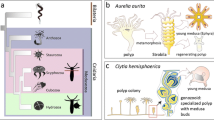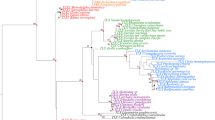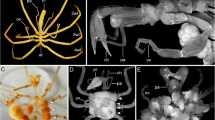Abstract
The life cycles of many cnidarian species are notable for including two stages with very different morphologies – sessile polyp and swimming medusa. Cnidarians thus provide an opportunity to study the developmental bases of differences in body organization without the need to compare organisms of different taxa. Information about the two life cycle stages suggests the following questions about differences in their development. (1) Are the mouth and tentacle-bearing region (bell margin) specified using any of the same molecular mechanisms as in the polyp? (2) Has the oral-aboral axis of the medusa been truncated relative to that of the polyp by elimination of molecular processes specifying aboral tissue identity? (3) Is the elongated region between the hydrozoan medusa mouth and tentacle ring (the manubrium) patterned using processes that pattern the entire oral-aboral axis in the polyp? We describe how data on their expression of FoxA, NK-2, and Emx genes during polyp and medusa development, together with reagents targeting specific signaling pathways, could be used to address these questions. We have isolated portions of a FoxA2 homologue, an NK-2 gene, and two Emx genes from Podocoryna carnea Sars, an experimentally tractable hydrozoan with both polyp and medusa stages. Phylogenetic analyses indicate that the two P. carnea Emx genes are the result of a gene duplication.
Similar content being viewed by others
References
H.R. Bode (2003) ArticleTitleHead regeneration in Hydra Developmental Dynamics 226 225–236 Occurrence Handle10.1002/dvdy.10225 Occurrence Handle12557201
Bode, P. M. & H. R. Bode, 1984. Patterning in hydra. In Malacinski, G. M. & S. V. Bryant (eds), Pattern Formation: A Primer in Developmental Biology. Macmillan Publishing Co. 213–241.
U. Boelsterli (1977) ArticleTitleAn electron microscopic study of early developmental stages, myogenesis, oogenesis and cnidogenesis in the anthomedusa, Podocoryne carnea M. Sars. Journal of Morphology 154 259–290 Occurrence Handle10.1002/jmor.1051540206 Occurrence Handle21970 Occurrence Handle1:STN:280:CSeD2cfjsFM%3D
J. Bouillon (1985) ArticleTitleEssai de classification des Hydropolypes-Hydromeduses (Hydrozoa-Cnidaria) Indo-Malayan Zoology 1 29–243
D. Bridge C.W. Cunningham B. Schierwater R. DeSalle L.W. Buss (1995) ArticleTitleClass-level relationships in the phylum Cnidaria: evidence from mitochondrial genome structure Proceedings of the National Academy of Sciences of the USA 89 8750–8753
M. Broun H.R. Bode (2002) ArticleTitleCharacterization of the head organizer in hydra Development 129 875–884 Occurrence Handle11861471 Occurrence Handle1:CAS:528:DC%2BD38XitFygsbo%3D
M. Broun S. Sokol H.R. Bode (1999) ArticleTitleCngsc, a homologue of goosecoid, participates in the patterning of the head, and is expressed in the organizer region of Hydra Development 126 5245–5254 Occurrence Handle10556050 Occurrence Handle1:CAS:528:DC%2BD3cXmtFOmsQ%3D%3D
E. Browne (1909) ArticleTitleThe production of new hydranths in hydra by the insertion of small grafts Journal of Experimental Zoology 7 1–37 Occurrence Handle10.1002/jez.1400070102
R.C. Brusca G.J. Brusca (2002) Invertebrates EditionNumber2 Sinauer Sunderland, MA
R.D. Campbell (1967) ArticleTitleTissue dynamics of steady state growth in Hydra littoralis. II. Patterns of tissue movement. Journal of Morphology 121 19–28 Occurrence Handle10.1002/jmor.1051210103 Occurrence Handle4166265 Occurrence Handle1:STN:280:CCiB3crjt1U%3D
A.G. Collins (2002) ArticleTitlePhylogeny of Medusozoa and the evolution of cnidarian life cycles Journal of Evolutionary Biology 15 418–432 Occurrence Handle10.1046/j.1420-9101.2002.00403.x
R.S. Devon D.J. Porteous A.J. Brookes (1995) ArticleTitleSplinkerettes–improved vectorettes for greater efficiency in PCR walking Nucleic Acids Research 23 1644–1645 Occurrence Handle7784225 Occurrence Handle1:CAS:528:DyaK2MXlvFaks7k%3D
U. Frank T. Leitz W.A. Muller (2001) ArticleTitleThe hydroid Hydractinia: a versatile, informative cnidarian representative Bioessays 23 963–971 Occurrence Handle11598963 Occurrence Handle1:STN:280:DC%2BD3MrltFSnug%3D%3D
M.A. Frohman G.R. Martin (1989) ArticleTitleRapid amplification of cDNA ends using nested primers Techniques 1 165–170
B. Galliot V. Schmid (2002) ArticleTitleCnidarians as a model system for understanding evolution and regeneration International Journal of Developmental Biology 46 39–48 Occurrence Handle11902686
A. Grens L. Gee D.A. Fisher H.R. Bode (1996) ArticleTitleCnNK-2, an NK-2 Homeobox gene, has a role in patterning the basal end of the axis in hydra Developmental Biology 180 473–488 Occurrence Handle10.1006/dbio.1996.0321 Occurrence Handle8954720 Occurrence Handle1:CAS:528:DyaK2sXmsVGl
B. Hobmayer F. Rentzsch K. Kuhn C.M. Happel C.C. von Laue P. Snyder U. Rothbacher T.W. Holstein (2000) ArticleTitleWNT signalling molecules act in axis formation in the diploblastic metazoan Hydra Nature 407 186–189 Occurrence Handle10.1038/35025063 Occurrence Handle11001056 Occurrence Handle1:CAS:528:DC%2BD3cXmvVSmtrw%3D
T.W. Holstein E. Hobmayer U. Technau (2003) ArticleTitleCnidarians: an evolutionarily conserved model system for regeneration Developmental Dynamics 226 257–267 Occurrence Handle10.1002/dvdy.10227 Occurrence Handle12557204 Occurrence Handle1:STN:280:DC%2BD3s%2FkslSntA%3D%3D
L.H. Hyman (1940) The Invertebrates: Protozoa Through Ctenophora McGraw-Hill New York
J. Kim W. Kim C.W. Cunningham (1999) ArticleTitleA new perspective on lower metazoan relationships from 18S rDNA sequences Molecular Biology and Evolution 16 423–427 Occurrence Handle10331269 Occurrence Handle1:CAS:528:DyaK1MXhvVOqtb8%3D
D.E. Martínez M.L. Dirksen P.M. Bode M. Jamrich R.E. Steele H.R. Bode (1997) ArticleTitleBudhead, a fork head/HNF-3 homologue, is expressed during axis formation and head specification in hydra Developmental Biology 192 523–536 Occurrence Handle9441686
L.M. Masuda-Nakagawa H. Groer B.L. Aerne V. Schmid (2000) ArticleTitleThe HOX-like gene Cnox2-Pc is expressed at the anterior region in all life cycle stages of the jellyfish Podocoryne carnea Development, Genes and Evolution 210 151–156 Occurrence Handle10.1007/s004270050022 Occurrence Handle1:CAS:528:DC%2BD3cXhtFGit7k%3D
D.J. Miller E.E. Ball (2000) ArticleTitleThe coral Acropora: what it can contribute to our knowledge of metazoan evolution and the evolution of developmental processes Bioessays 22 291–296 Occurrence Handle10.1002/(SICI)1521-1878(200003)22:3<291::AID-BIES11>3.0.CO;2-2 Occurrence Handle10684589 Occurrence Handle1:CAS:528:DC%2BD3cXjsFCntLw%3D
O. Mokady M.H. Dick D. Lackschewitz B. Schierwater L.W. Buss (1998) ArticleTitleOver one-half billion years of head conservation? Expression of an ems class gene in Hydractinia symbiolongicarpus (Cnidaria: Hydrozoa) Proceedings of the National Academy of Sciences of the USA 95 3673–3678 Occurrence Handle10.1073/pnas.95.7.3673 Occurrence Handle9520424 Occurrence Handle1:CAS:528:DyaK1cXitlKjtrw%3D
J.J. Otto R.D. Campbell (1977) ArticleTitleBudding in Hydra attenuata: bud stages and fate map Journal of Experimental Zoology 200 417–428 Occurrence Handle10.1002/jez.1402000311 Occurrence Handle874446 Occurrence Handle1:STN:280:CSiB3cfpt1U%3D
P. Schuchert (1993) ArticleTitlePhylogenetic analysis of the Cnidaria Zeitschrift fuer Zoologische Systematik und Evolutionsforschung 31 161–173
D. Spangenberg (1965) ArticleTitleA study of strobilation in Aurelia aurita under controlled conditions Journal of Experimental Zoology 160 1–10 Occurrence Handle10.1002/jez.1401600102
J. Spring N. Yanze C. Josch A.M. Middel B. Winninger V. Schmid (2002) ArticleTitleConservation of Brachyury, Mef2, and Snail in the myogenic lineage of jellyfish: a connection to the mesoderm of bilateria Developmental Biology 244 372–384 Occurrence Handle10.1006/dbio.2002.0616 Occurrence Handle11944944 Occurrence Handle1:CAS:528:DC%2BD38Xis1ygsLk%3D
D.L. Swofford (2003) PAUP*. Phylogenetic Analysis Using Parsimony (*and Other Methods). Sinauer Associates Sunderland, MA
G. Webster L. Wolpert (1966) ArticleTitleStudies on pattern regulation in hydra. I. Regional differences in time required for hypostome determination. Journal of Embryology and Experimental Morphology 16 91–104 Occurrence Handle4381889 Occurrence Handle1:STN:280:CCiC2srkslw%3D
B. Werner C.E. Cutress J.P. Studebaker (1971) ArticleTitleLife cycle of Tripedalia cystophora Conant (Cubomedusae) Nature 232 582–583 Occurrence Handle16063105 Occurrence Handle1:STN:280:DC%2BD2Mvgt1Wjuw%3D%3D
N.A. Williams P.W. Holland (2000) ArticleTitleAn amphioxus Emx homeobox gene reveals duplication during vertebrate evolution Molecular Biology and Evolution 17 1520–1528 Occurrence Handle11018158 Occurrence Handle1:CAS:528:DC%2BD3cXnt1Cnsbg%3D
Author information
Authors and Affiliations
Corresponding author
Rights and permissions
About this article
Cite this article
Bridge, D.M., Ha, C.T., Nemir, A. et al. Variations on a theme? Polyp and medusa development in Podocoryna carnea . Hydrobiologia 530, 299–307 (2004). https://doi.org/10.1007/s10750-004-2640-1
Issue Date:
DOI: https://doi.org/10.1007/s10750-004-2640-1




